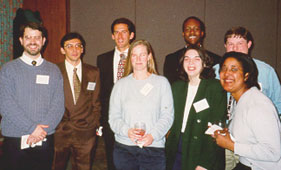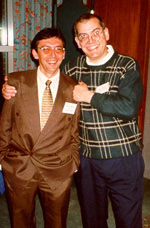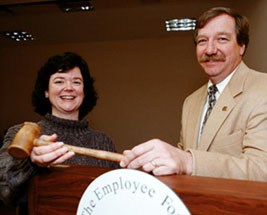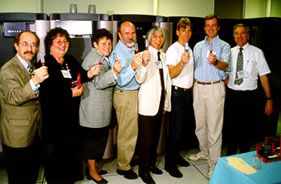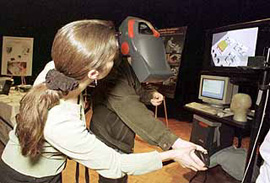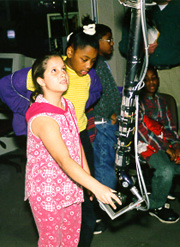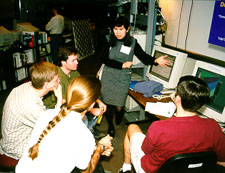Alumni news
MS/PhD Alumni
Ron Azuma (Ph.D. 1995) has several recent papers:
Azuma, R. T. "The Challenge of Making Augmented Reality
Work Outdoors," Proc. First International Symposium
on Mixed Reality, Yokohama, Japan, 9-11 March
1999.
Azuma, R., B. Hoff, H. Neely III, and R. Sarfaty. "A
Motion-Stabilized Outdoor Augmented Reality System," Proc.
IEEE VR '99, Houston, Texas, 13-17 March 1999,
252-259.
You, S., U. Neumann, and R. Azuma. "Hybrid Inertial and
Vision Tracking for Augmented Reality Registration,"
Proc. IEEE VR '99, Houston, Texas, 13-17 March
1999, 260-267.
Ron is at HRL Laboratories in Malibu, Calif.
(azuma@HRL.com)
Mike Capps (M.S. 1996) has an upcoming
publication:
Watsen, K., R. Darken, and M. Capps. "A Handheld
Computer as an Interaction Device to a Virtual
Environment," to appear in Proc. Immersive Projection
Technology Workshop, Stuttgart, Germany, May 1999.
Mike organized the third annual "System Aspects of Sharing
a Virtual Reality" workshop at IEEE Virtual Reality '99 in
March. He has been chosen as the technical program chair
for the VRML 2000/Web3D conference, and as workshops
chair for VR2000. (capps@vr.edu)
Mike Carr (M.S. 1991) was recently promoted to
group manager at Wavetek, Wandel & Goltermann (www.wg.com) in
Research Triangle Park, N.C. He is in charge of the
department that produces the Domino network analyzer for
10/100Mb Ethernet, Gigabit Ethernet, Token Ring, WAN,
and FDDI networks, and is responsible for hardware and
software development and response to worldwide reports of
problems from the field. Mike and his wife Susie still live just
outside Chapel Hill on their eight-acre "mini-ranch,"
complete with two horses. (mike.carr@wg.com)
Dick Craddock (M.S. 1986) was promoted to
product unit manager of the Macintosh Internet Products
group at Microsoft Corp. in March 1998. Dick's group
develops Internet Explorer (IE) and Outlook Express (OE) for
the Macintosh. At this year's MacWorld Expo in San
Francisco, Mac Outlook Express 4.01 won a MacWorld
"Eddy" award, and Mac IE and OE 4.5 were honored with the
"Best of Show" award. For more information, see:
www.microsoft.com/mac
(craddock@ablecom.net)
John Gauch (Ph.D. 1989) licensed VidWatch, a
video signal verification system, from the University of
Kansas to Turner Broadcasting in February. VidWatch will
be deployed in Central and South America to verify the
broadcast of scheduled commercials.
(jgauch@ittc.ukans.edu)
Lenny Heath (Ph.D. 1985) has a recent publication:
Heath, L. S., and J.P.C. Vergara. "Sorting by Bounded
Block-Moves," Discrete Applied Mathematics, Vol. 88, 1998,
181-206.
Victoria Interrante (Ph.D. 1996), an assistant
professor at the University of Minnesota, was a participant in
the panel discussion at IEEE Visualization '98 entitled, "Art
and Visualization: Oil and Water?" which won the "Best
Panel" award. She was recently awarded a Grant-in-Aid of
Research, Artistry, and Scholarship from the Office of the
Vice President for Research and Dean of the Graduate
School of the University of Minnesota.
(interran@cs.umn.edu)
Chuck Mosher (M.S. 1987) has been promoted to
staff engineer at Sun Microsystems, where he is developing a
Java framework for data warehousing, decision support, and
OLAP. He now works from home and reports that he is loving
it. (chuck.mosher@sun.com)
Ryutarou Ohbuchi (Ph.D. 1994) has a couple of
recent papers:
Ohbuchi, R., H. Masuda, and M. Aono. "Watermarking
Three-Dimensional Polygonal Models Through Geometric
and Topological Modifications," IEEE Journal on
Selected Areas in Communication, 16(4), 1998, 551-560.
Ohbuchi, R., H. Masuda, and M. Aono. "Targeting
Geometrical and Non-Geometrical Components for Data
Embedding in Three-Dimensional Polygonal Models,"
Computer Communications, Vol. 21, 1998, 1344-1354.
Ryutarou is at IBM's Tokyo Research Lab. (ohbuchi@acm.org)
Amol Pattekar (M.S. 1998) recently joined Yahoo!,
Inc., in Santa Clara, Calif., as a "Technical Yahoo!" with the
Search Engine group. He previously worked for the Advanced
Graphics Group at Silicon Graphics, Inc.
(amol@yahoo-inc.com)
Injong Rhee (Ph.D. 1994), an assistant professor at
N.C. State University, recently received an NSF CAREER
award. (rhee@eos.ncsu.edu)
Lev Stesin (M.S. 1998) has left Silicon Graphics
Inc., and now works at Yahoo!, Inc. He lives in San
Francisco, Calif. (stesin@yahoo-inc.com)
Dave Tolle (Ph.D. 1981) resigned from Shell Oil
Company in March, after a 17-year career doing computer
science research and development. He plans to start his own
company, making software to teach mathematics to young
children. (DaveTolle@acm.org)
Juan Valiente (M.S. 1989) returned to his native El
Salvador after graduation. Currently, he is the executive
vice-president of Futurekids for El Salvador, Honduras,
Nicaragua, and Panama. He has been married to Claudia
Castillo since 1991. Their daughter, Alejandra, was born in
1995. Juan recently contributed to the publication, Basis for
the Nation Plan (January 1999), in a chapter on education.
(java@insatelsa.com)
John Q. Walker, II (Ph.D. 1991), vice president of
development at Ganymede Software, Inc., reports that his
company's product, Chariot 2.2, earned a World Class Award
from the journal Network World: Currier, B. "Chariot
Rides to the Rescue," Network World, 25 January
1999, 16(4). Ganymede's products measure and monitor the
performance of network hardware, software, and
applications. (johnq@GanymedeSoftware.com)
Undergraduate Alumni
Will Huffman (B.S. MSci. 1995) graduated from
Virginia Tech with a master's in systems engineering (with a
concentration in electrical engineering and a secondary in
business) in July 1998. He works for the Joint Warfare
Analysis Center in Dahlgren, Va., doing I/O protect and
multi-level security in the Networking and Connectivity
Branch. While an undergraduate at UNC-Chapel Hill, Will
worked for Computer Services from 1993 to 1995.
(whuffman@jwac.com)
Fred Lassiter (B.S. MSci. 1981) is completing a
fellowship in nuclear medicine this year and will soon begin
his second--and final--career in diagnostic radiology/nuclear
radiology in Richmond, Va. He is getting married for the first
time in June to Elizabeth Tornberg of Newport News, Va. He
reports that his late start on things is because, "like all math
majors, I was taught to analyze carefully!"
(XrayFred@aol.com)
Michelle Torian (B.S. MSci. 1998) is at IBM Corp. in
Atlanta, Ga. She also volunteers her time to help parents of
Atlanta public schoolchildren learn how to use MS Word and
the Internet. She reports that the skills she acquired as a
COMP 4 lab assistant come in very handy!
(mltorian@us.ibm.com)
Ann Whitmeyer (B.S. MSci. 1984) recently accepted
a position as the chief operating officer of Campbell Alliance
Group, a Raleigh-based business development consultancy
specializing in healthcare and technology.
(Ann_Whitmeyer@campbellalliance.com,
annw@whitmeyer.com)
Alumnus Leads Real-time Java Specification Process
Greg Bollella (Ph.D. 1997), an engineer at IBM
Corp. in Research Triangle Park, N.C., has been chosen by
Sun Microsystems to lead the Real-Time Java(TM)
specification process. As specification lead, Greg formed the
Real-Time Expert Group, which is composed of a core team
of industry leaders from Aonix, Cyberonics, Microware,
Nortel Networks, QNX, Rockwell Collins, and Sun
Microsystems, and an extended team including
representatives from Apogee, Carnegie Mellon University,
Lockheed Martin, Lucent, MITRE, Mitsubishi, Motorola,
NSICom, NIST, Schneider Automation, Thomson-CSF, and
Wind River Systems. The group is charged with developing a
specification for extending the Java platform with real-time
function. Implementations of the specification will give
developers the function they need to write real-time
applications in the Java programming language. This real-time
specification is aimed at broadening the market for Java
technologies and moving the platform forward using the
collective innovation of the industry.
Greg has been quoted in the press as saying that, "the
opportunity for embedded, real-time devices is so huge that
it dwarfs the PC market. In order for Java to be accepted in
the embedded and real-time systems industry, it is
imperative that we develop a real-time Java specification.
The Real-Time Expert Group is committed to delivering a
unified specification that will address the requirements of a
wide range of real-time programming styles and real-time
systems." For more information, visit Sun's Java Developer
Connection(SM) Web site at
java.sun.com/jdc and follow the
Java Community Process link.
The idea of developing specifications for real-time Java has
its roots in our Department. Greg completed his dissertation,
"Slotted Priorities: Supporting Real-Time Computing Within
General-Purpose Operating Systems," in 1997 under the
direction of Kevin Jeffay, associate professor.
Looking for a way to continue his dissertation work at IBM,
where he worked during and after earning his degree, Greg
began the effort within the industry to establish a
specification for real-time Java. His work led to an industry
consortium being formed to look into a standard, then to a
much larger standardization effort, and then to a dispute
among the big computer vendors as to how the standard
should be created and whether Sun should own it. The
dispute has quieted, and Greg's expert group is moving
forward and expects to finish the specification by the end of
the year. (bollella@us.ibm.com)

External review
From 14-16 February 1999, our Department hosted a panel
of distinguished scientists who reviewed our graduate
program. The reviewers were James H. Morris of
Carnegie Mellon University, the committee's chair;
Barbara Liskov of the Massachusetts Institute of
Technology; Lee G. Pedersen of the Chemistry
Department at UNC-Chapel Hill; Richard F.
Riesenfeld of the University of Utah; and William
Wulf of the University of Virginia and president of the
National Academy of Engineering.
The reviewers' overall assessment was that "the University of
North Carolina has a superb Computer Science (CS)
department!" They praised the extent of our collaboration
with other academic departments, both at UNC-Chapel Hill
and at other universities, as well as with industry, and were
impressed by the research we are conducting in several
areas including graphics and imaging, computer-supported
cooperative work, human computer interaction, high
performance computing, and scientific visualization,
observing that there are also "few but excellent faculty in
several other areas of CS." They also praised the
Microelectronic Systems Laboratory as a unique asset.
The reviewers recommendations were:
Re-examine the strategy of staying "small and excellent in a
few areas":
The reviewers agreed that "a major university should have
a 'full service' CS department."
Strengthen and expand research areas other than graphics:
The reviewers recommended that "building in a field allied
to graphics and leveraging the excellence there" would be
more effective than trying to represent all research areas of
computer science. They suggested algorithms allied to
graphics and computational geometry, computational
geometry, computer-supported cooperative work, high
performance computing, human computer interaction, and
scientific visualization as potential areas.
Begin designing and planning for a modern undergraduate
major. Revive the program for non-majors:
The reviewers considered the creation of an undergraduate
major to be "long overdue" (the Department submitted a
proposal for an undergraduate major to UNC's General
Administration in January). The reviewers voiced concern
over whether the university would provide the necessary
resources for us to implement both the undergraduate and
non-major programs.
Begin an external/internal search for a new chair now:
The reviewers strongly recommended "that the department
begin an external search even if, in the end, it chooses an
internal candidate. To fail to search externally will always
leave open the question of whether a new, compatible, and
energetic vision could have been found."
Form a partnership with the College of Arts and Sciences to
guide computer education at UNC-Chapel Hill:
The reviewers observed that the College "appears poised to
invest in CS. Assertions made about the importance of CS
need to materialize in concrete ways, and promises made
about resources must be kept."
Change the Department's vision of itself and of its role:
The reviewers felt that "the department must learn to see
itself--and have itself seen--as a part of the larger
university, with responsibilities to the citizens of North
Carolina--not as just an isolated graduate research
institute." They noted that the Department has done this
very well with regard to research collaborations, but not
with regard to undergraduate education.
Department faculty will hold the first of several retreats in
May to plan the Department's future.

About News & Notes
News & Notes is published three times
a year in fall, winter, and spring.
Co-editors:
Jeannie M. Walsh,
walsh@cs.unc.edu
Claire L. Stone,
stonec@cs.unc.edu
Keep in touch!
Let us know where you are and what you are
doing so that we can include you in our next issue! Send us
information via e-mail to pubs@cs.unc.edu; fax it to
919-962-1799; or mail it to the address below, c/o News
&
Notes.
Please include your e-mail address.
Department of Computer Science
UNC-Chapel Hill
CB#3175, Sitterson Hall
Chapel Hill, NC 27599-3175
General information:
Voice: 919/962-1700
Fax: 919/962-1799
Internet mail: info@cs.unc.edu
World Wide Web:
www.cs.unc.edu
Address corrections, submissions, and for information
about our publications:
pubs@cs.unc.edu
UNC is an Equal Opportunity/Affirmative Action Institution.

Page maintained by: Department of Computer Science,
UNC-Chapel Hill
Server Manager: webmaster@cs.unc.edu
Content Manager: pubs@cs.unc.edu
Last Content Review: 23 April 1999
 To the Department's home page
To the Department's home page



